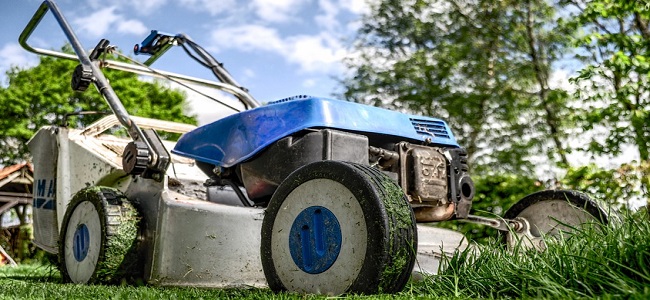.
Mowing is an art and the mower you employ will determine the lawn you create. Forget, for a moment, all the stuff about battery or petrol-driven mowers, self-propelled machines or programmed robots. That’s secondary. The first requirement is the cutting of the grass and lawnmowers, whatever the sales talk, divide into two categories – they have cylinder or rotary action, and there are many models of each type available.
Cylinder mowers are for lawn perfectionists but you need a flat lawn, without tufts. It is also best if the grass is already short as many cylinder mowers will stall in long grass. This is because cylinder mowers have a cutting edge close to the ground over which the cylinder blades pass over. Lumps of earth – and sometimes long grass — will jam the cylinder as it moves over the cutting edge, and eventually damage the machine. All the same, if you want an immaculate, striped lawn, a cylinder mower combined with a built-in roller is and has been essential. For generations, Derby-based Qualcast founded in the 19th century set the standard, followed by Stowmarket-based Atco founded in 1921. Today they are a single company.
People looking for low maintenance prefer rotary mowers. The rotary system comprises a blade turning above the ground in rotary action like a helicopter, so there is less jamming on bumps in the turf and when tufts of grass are encountered. This spinning blade system was popularised by Flymo back in the 1970s, when the Swede Karl Darlman invented and marketed a ‘hovering’ wheel-less machine; but since then there have been many competitors and most manufacturers have gone over to a rotary line of production. Generally, Hayter is seen as one of the better British builders, but Atco has also moved into rotary machines, as have Mountfield and others.
The problem with the rotary Flymo, and similar competitors, was the electrical cable. These are known as ‘corded’ machines. The cable constrains movement around the lawn and often, in the case of more people than would want to admit it, gets severed accidentally. This gave petrol driven mowers an advantage on large lawns; serious gardeners, especially in the US, avoided the Flymo because its ’hovering’ action meant that it left no clean lines on the lawn. In other words, it didn’t give a neat and tidy effect, although for getting into awkward corners and under and around trees, the Flymo system was and remains of great utility.
Until recently, petrol mowers retained a number of advantages, especially for large lawns. The motor drives a chain which allows the mower to be self-propelled, reducing the effort required, and often has a roller to flatten the grass. The drawback for the average gardener was always the maintenance required, although petrol mowers still command a loyal following among people knowledgeable about petrol engines and know how to tinker with carburettors, spark-plugs and air-filters.
.
The threat to petrol lawnmowers comes from battery innovations in recent years. With the development of lithium-ion battery technology, mowers have recently been developed with batteries of longer durability, cutting the need for recharging. The first battery lawnmowers were suitable for small lawns and had in situ batteries that needed recharging. Lawnmowers are now available with longer battery times with interchangeable batteries, so you don’t need to wait for recharging, but can insert a new charged battery. Stihl, which also makes corded and petrol mowers, has been at the forefront of these developments, and is regarded highly by some professional gardeners; but Hayter and Hyundai also make battery lawnmowers. Hyundai tends to be good value for money, but there are drawbacks to be considered with mowers at the cheaper end of the range.
Many of the lithium-ion battery mowers on the market now are not self-propelled but push mowers. They also tend to lack a heavy roller that will make neat stripes. These factors need to be considered when buying. In the US, the average mowing time is 75 minutes and that can amount to a lot of pushing. Battery technology still isn’t up the level where weighted lawnmowers can last for long periods.
The other trend in lawn mowing of course is robotic lawnmowers, where in theory you don’t have to perform any lawn mowing at all but can program a robotic mower to cut a lawn set within defined parameters. They use lithium-ion batteries and are controlled by GPS and Wifi and are in theory manageable from your phone. Many are now on the market, with a number of new entrants. They range from the Worx Landroid M 20V at the cheaper end to the Honda Milmo HRM 310 at the top end of the range. Those interested should be wary there can be many drawbacks in terms of control – and the top-end models need a lot of setting up. Robomow has good reviews and is perhaps the best for larger lawns.
There was a time when lawn mowing was a therapeutic activity for men on Saturday mornings after a week in the office, but those days are going. There are still perfectionists around who want nothing less than an Atco Balmoral, or Qualcast Suffolk Punch, delivering neat stripes and a low-cut, but they are very much a minority. On the whole, the trend to robotics and lithium batteries will remain, but the technology hasn’t perhaps yet developed to the point where it is suitable for everyone – and you will still need to come back with a rotary non-robotic to go over areas outside the ‘designated area‘ of the robot. As with all things, it’s now about the IT.

